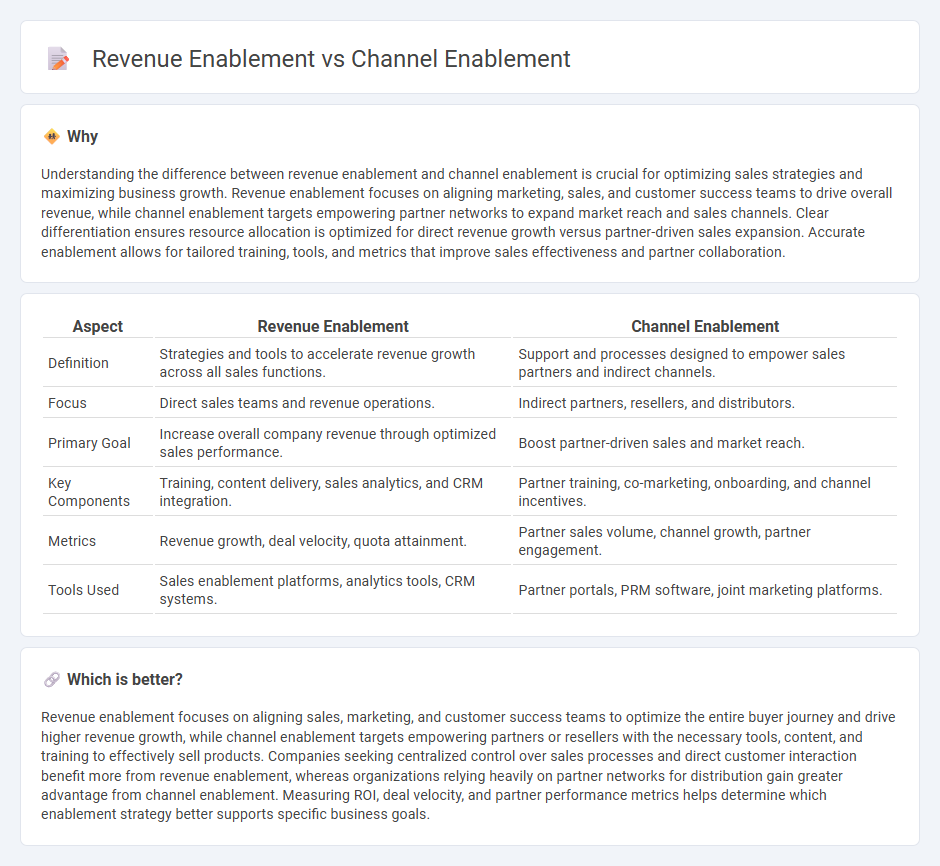
Revenue enablement focuses on aligning sales, marketing, and customer success teams to drive consistent revenue growth by providing targeted resources and training. Channel enablement emphasizes empowering partner networks with the necessary tools, knowledge, and support to effectively sell and promote a company's products or services. Explore how these distinct approaches can optimize your business performance and accelerate sales cycles.
Why it is important
Understanding the difference between revenue enablement and channel enablement is crucial for optimizing sales strategies and maximizing business growth. Revenue enablement focuses on aligning marketing, sales, and customer success teams to drive overall revenue, while channel enablement targets empowering partner networks to expand market reach and sales channels. Clear differentiation ensures resource allocation is optimized for direct revenue growth versus partner-driven sales expansion. Accurate enablement allows for tailored training, tools, and metrics that improve sales effectiveness and partner collaboration.
Comparison Table
| Aspect | Revenue Enablement | Channel Enablement |
|---|---|---|
| Definition | Strategies and tools to accelerate revenue growth across all sales functions. | Support and processes designed to empower sales partners and indirect channels. |
| Focus | Direct sales teams and revenue operations. | Indirect partners, resellers, and distributors. |
| Primary Goal | Increase overall company revenue through optimized sales performance. | Boost partner-driven sales and market reach. |
| Key Components | Training, content delivery, sales analytics, and CRM integration. | Partner training, co-marketing, onboarding, and channel incentives. |
| Metrics | Revenue growth, deal velocity, quota attainment. | Partner sales volume, channel growth, partner engagement. |
| Tools Used | Sales enablement platforms, analytics tools, CRM systems. | Partner portals, PRM software, joint marketing platforms. |
Which is better?
Revenue enablement focuses on aligning sales, marketing, and customer success teams to optimize the entire buyer journey and drive higher revenue growth, while channel enablement targets empowering partners or resellers with the necessary tools, content, and training to effectively sell products. Companies seeking centralized control over sales processes and direct customer interaction benefit more from revenue enablement, whereas organizations relying heavily on partner networks for distribution gain greater advantage from channel enablement. Measuring ROI, deal velocity, and partner performance metrics helps determine which enablement strategy better supports specific business goals.
Connection
Revenue enablement and channel enablement are interconnected by aligning sales strategies with partner ecosystems to drive consistent revenue growth. Channel enablement equips partners with the tools, training, and resources necessary to effectively promote and sell products, enhancing overall revenue performance. Effective revenue enablement integrates these efforts to optimize sales processes across direct and indirect channels, maximizing market reach and profitability.
Key Terms
Channel Enablement:
Channel enablement focuses on equipping partners, resellers, and distributors with the tools, resources, and training needed to effectively sell and support a company's products or services. It emphasizes optimizing partner engagement, improving sales readiness, and streamlining communication to drive mutual growth through indirect sales channels. Explore deeper insights into channel enablement strategies to maximize partner performance and revenue generation.
Partner Training
Channel enablement centers on equipping partners with training and resources to effectively sell and support products, enhancing overall market reach. Revenue enablement integrates partner training with sales strategies and performance analytics to drive measurable business outcomes. Explore detailed insights to optimize partner training for maximizing revenue impact.
Channel Incentives
Channel enablement emphasizes empowering partners with training, resources, and support to effectively promote products, while revenue enablement targets aligning sales and marketing efforts to maximize revenue generation. Channel incentives play a critical role by motivating partners through rewards such as rebates, bonuses, and performance-based benefits that drive engagement and sales growth. Explore more about optimizing channel incentives to boost your revenue and partner success.
Source and External Links
What Is Channel Enablement? [Definition] - Impartner - Channel enablement is the process of equipping channel partners with the skills, resources, and tools they need to effectively sell and market products or services, leading to increased sales, efficiency, customer satisfaction, and brand consistency.
The Best Strategies for Channel Sales Enablement - Showell - Channel sales enablement involves providing partners access to knowledge, skills development, and tailored sales materials through a centralized system to empower them to sell effectively and efficiently.
Top channel trends: Partner enablement strategies that work - ITA Group - Partner enablement is a comprehensive approach that empowers channel partners with knowledge, skills, product content, demand generation strategies, and support to promote and sell products successfully, reflecting the evolving needs of partners and customers.
 dowidth.com
dowidth.com